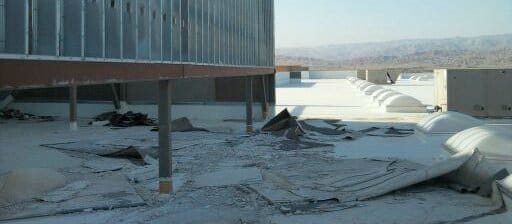
Emergency repairs are inevitable over the course of a roof’s life. When leaks or other issues arise, building owners with a plan can handle emergency repairs quickly and efficiently and then move on. Failing to establish a plan, on the other hand, forces the delay of critical repairs and jeopardizes the integrity of the roof system, as well as the safety of the people in the building.
Emergency Plans: a Non-Optional Aspect of Roof Management
Roofs are subject to the elements, impact from debris, and even hurricanes and tornadoes in some regions. In this sense, no emergency should ever be entirely unexpected. Building owners should anticipate and plan for possible setbacks, making it easier to take action quickly and strategically in the event of an emergency. The first step to address roof issues as they arise is to have an action plan ready for when — not if — they occur. Planning — and budgeting — for a roof emergency is a natural and necessary part of roof management.
Without a plan, immediate repairs may have to be put off. Left unchecked, even small issues can turn into larger problems that compromise the safety of the employees or customers within. Unresolved leaks can lead to costly slip-and-fall lawsuits, (especially in retail locations), or inspection violations from health officials or OSHA. Even if a leak never makes it inside the building, moisture can compromise the structural integrity of the building or grow mold. Every building owner should prepare a plan and budget so that he or she can take immediate action in the event of an emergency and minimize the spread of the issue.
Prepare a Reliable Emergency Plan: Must-Have Inclusions
All emergency plans should work in conjunction with the building’s regular maintenance plan. The two plans should include the following:
- Schedule: The single most important part of any roof emergency plan is a regular inspection and maintenance schedule. Routine inspections identify weak points and enable building owners to proactively prevent issues as opposed to reacting to damage as it occurs; this is the single most effective strategy to save on costly repairs.
- Initial inspection: The initial inspection should be slow and thorough to identify and record even the smallest deficiencies in the roof system. Contractors should examine the entire roof system and inspect every detail.
- Repair priorities: If the inspection reveals any deficiencies, they should fall into two different categories established in the emergency plan: immediate repairs and long-term repairs. A good plan enables building owners to deal with the most pressing anomalies first, while shelving issues that can be deferred to budget for them strategically.
- Records of emergency work: Any emergency work should be documented, photographed, and catalogued in case anything is missed due to the accelerated nature of emergency repairs.
Even the most rigorously inspected and maintained buildings are subject to nature and the realities of structural decline. However, owners can prevent or minimize many costly anomalies with simple preparation and planning; many “emergencies” are predictable given the knowledge of the building’s age, construction, and location. When building owners establish smart, flexible plans to handle emergencies that will inevitably arise, they empower themselves to make repairs without interrupting daily operations.
